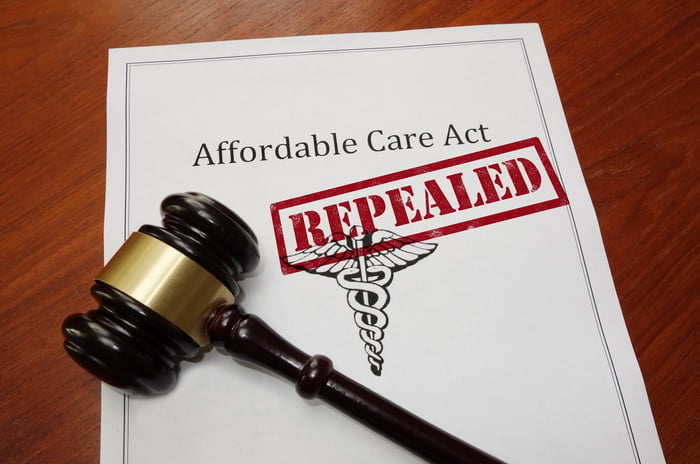The big day has now come and gone. Yesterday, Republicans in the Senate unveiled their long-awaited healthcare reforms designed to repeal and replace the Affordable Care Act (ACA), which you probably know best by now as Obamacare.
How we got here
In March, House Republicans introduced the world to the American Health Care Act (AHCA), which some have dubbed "Trumpcare." After less than three weeks of back-and-forth debates among GOP members in the House, the AHCA was swept from the docket without going to vote because there wasn't enough support to pass the initial version.

Image source: President Donald J. Trump's official Facebook page. Photo by Shealah Craighead.
A little more than a month later, a second version of the bill emerged. It kept most of the initial version of the AHCA intact, but it added two new amendments designed to appease factions of the Republican Party who opposed the initial version.
For more moderate House Republicans who felt that the AHCA would take away too much from sicker constituents, the Upton Amendment was introduced. It added $8 billion in additional funds (on top of a proposed $100 billion) to help states curb the inflationary pressures of treating patients with pre-existing conditions. For the Freedom Caucus, a group of GOP members who believe the AHCA didn't go far enough in distancing itself from Obamacare, the MacArthur Amendment was introduced, which allows states the option of applying for a waiver from Obamacare's 10 essential minimum benefits clause that each health plan is required to have.
This secondary version of the AHCA passed by the narrowest of margins in the House. Here's a quick refresher of its key points:
- Obamacare's individual and employer mandates would be repealed, as well as the penalty for not purchasing health insurance.
- Income-based subsidies would be replaced with age-based tax credits.
- Medicaid would be doled out to states on a per-capita basis, and Medicaid expansion would cease as of Jan. 1, 2020.
- Older adults could be charged up to 67% more for their premiums relative to younger adults than under Obamacare.
- $108 billion would be set aside between 2018 and 2026 to help control premium inflation for those with pre-existing conditions.
- Insurers would be allowed to add a 30% surcharge to the premiums of persons who did not have continuous coverage in the previous year.
- Annual allowable contributions to a health savings account would nearly double.
- The net investment income tax and Medicare surtax would eventually be eliminated.
- Children under the age of 26 could stay on their parents' plan, exactly as under Obamacare.
- The ACA's minimum essential health benefits clause would remain in place, but states would be allowed to apply for a waiver to opt out.

Image source: Getty Images.
Of course, there were a lot of concerns with this plan. In particular, there were worries that stripping away income-based subsidies and replacing them with age-based credits would leave millions of low-income individuals and families on the outside looking in. There were also concerns about the elderly having to pay significantly more under Trumpcare than Obamacare, as well as folks with pre-existing conditions potentially being charged more.
A handful of prominent Senate Republicans called the bill "dead on arrival" following the House vote. This pretty much set the table for Senate Republicans to craft their own version of healthcare reform, which was unveiled on Thursday.
Introducing the Better Care Reconciliation Act
The 142-page bill introduced by Senate Republicans, known as the Better Care Reconciliation Act (BCRA), kept a few components of the House's healthcare reform proposal, but really branched off to become its own unique bill.
For instance, the BCRA would retroactively repeal the Shared Responsibility Payment (the penalty paid for not buying health insurance) all the way to the beginning of 2016, which is pretty similar to the repeal of the mandates and penalties described in the House bill. It also eliminates taxes on the wealthy, such as the 3.8% net investment income tax on individuals with more than $200,000 in modified adjusted gross income (MAGI), and the Medicare surtax of 0.9% on persons with MAGI above $200,000.

Image source: Getty Images.
But there are some very notable differences between the two plans. Here are a few biggies:
- Income-based subsidies: The Senate bill reverses the switch to age-based tax credits and goes back to income-based subsidies, as under Obamacare. However, the income-based subsidies aren't as generous for older adults, and they only cover folks earning up to 350% of the federal poverty level instead of 400% as under Obamacare. It would likely mean fewer middle-class folks finding affordable insurance and the elderly paying more out of pocket than under Obamacare.
- Cost-sharing reductions are extended (but still eliminated): Whereas the AHCA would eliminate cost-sharing reductions (CSRs) immediately, the BCRA allows them to remain in place, with full federal funding, through 2019. After 2019, they would be eliminated. This provides some temporary relief for lower-income families but makes affording going to the doctor very difficult in 2020 and beyond.
- Medicaid expansion is extended (but still eliminated): The BCRA would honor the pledge of Obamacare to provide 90% of the costs of Medicaid expansion through 2020, but would then decrease the amount of funding provided to states by 5% each year until it's eliminated entirely by 2023.
- Medicaid spending: As with the AHCA, money doled out to states would be done on a per-capita basis through 2025. After 2025, growth in Medicaid spending would change from the Consumer Price Index (CPI) for medical care to the general CPI, which would mean lower increases in payouts to states.
- Medicaid work requirements: As has long been a desire of Republicans, the Senate health bill allows states to create a provision for Medicaid recipients that they must maintain employment for a period of time, excluding the disabled, pregnant women, and students. The definitions of "employment" and "period of time" are both gray areas, but it's nonetheless a measure designed to ensure that Americans aren't getting a free ride.
- Essential benefits waiver (with a twist): As with the AHCA, the BCRA allows states the option of opting out of the minimum essential health benefits clause. However, unlike the House plan, it does not allow states to repeal the community rating, which is the provision that mandates all people of the same age in the same location be charged the same premium. In other words, it provides protection for those with pre-existing conditions.
There are a few other changes, but these are the most important.

Image source: Getty Images.
These four GOP Senators are digging in their heels
As you might expect, the Senate's bill isn't without controversy. While making healthcare more affordable for a number of healthier young adults, and providing protections for those with pre-existing conditions that weren't available under the AHCA, the BCRA has its drawbacks. For example, the middle class would take a hit with the federal poverty subsidy limits being scaled back. Additionally, older Americans still face significantly higher costs, especially those who qualify for a subsidy.
Given what look to be some glaring problems with the bill, four Republican Senators have dug in their heels and announced that they have no intention of voting in favor of the current bill as it reads. They did not say they'll be voting no, but made it clear that further discussion would be needed before they would consider voting in favor of the BCRA.
The four GOP senators are:
- Ted Cruz (R-Texas)
- Rand Paul (R-Ky.)
- Ron Johnson (R-Wis.)
- Mike Lee (R-Utah)
All four senators released a joint statement that reads:
Currently, for a variety of reasons, we are not ready to vote for this bill, but we are open to negotiation and obtaining more information before it is brought to the floor.
There are provisions in this draft that represent an improvement to our current healthcare system, but it does not appear this draft as written will accomplish the most important promise that we made to Americans: to repeal Obamacare and lower their healthcare costs.
Though the Senate bill has yet to be scored by the Congressional Budget Office, which is what's halted moving the bill to the floor for debate and vote, chances are good that it'll provide the long-term reduction in healthcare costs that Rand Paul and his peers are seeking.

Image source: Getty Images.
It's no secret that both the AHCA and BCRA are probably going to be disliked by the public, but they do appear to provide health insurers with much-needed flexibility in pricing their plans. The waiver mandates and ability to charge older folks more (since older adults are often sicker than younger adults) is viewed as a critical component to keeping insurers involved, as well as to lowering healthcare premiums. National insurers UnitedHealth Group, Humana, and Aetna, were losing money hand over fist on Obamacare's exchanges and recently cut their coverage dramatically for 2017. Humana has said that it plans to pull out of the Obamacare exchanges entirely by next year.
The danger in the Republican Senate health bill is that also allows insurers to pass along more out-of-pocket costs to consumers via higher deductibles. In other words, if you actually need to go to the doctor, you could be paying a lot more.
What's more, Cruz, Paul, Johnson, and Lee are unlikely to get their way in distancing themselves any further from Obamacare, because doing so would mean rolling back subsidies on lower-income folks, which a vast majority of the American public have said they disagree with.
As a reconciliation bill, the Senate only needs 50 votes for passage, since it's almost certain that Vice President Mike Pence would break the tie. Getting to 50 could still prove exceptionally challenging when, according to party lines, Republicans can only afford to lose two votes. With a July 4th recess looming, it looks as if healthcare reform may drag into late summer or the fall.




